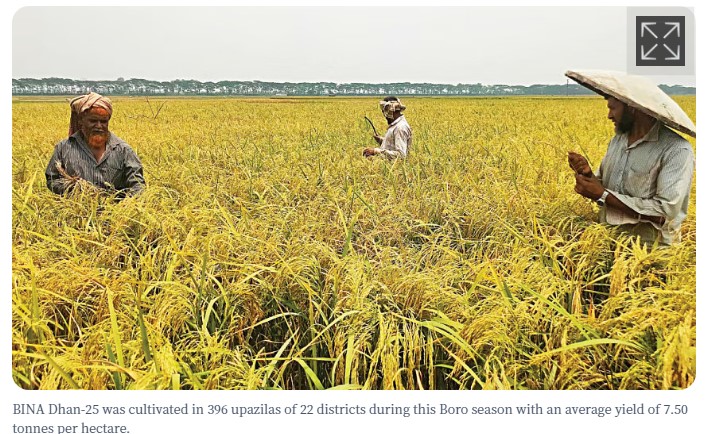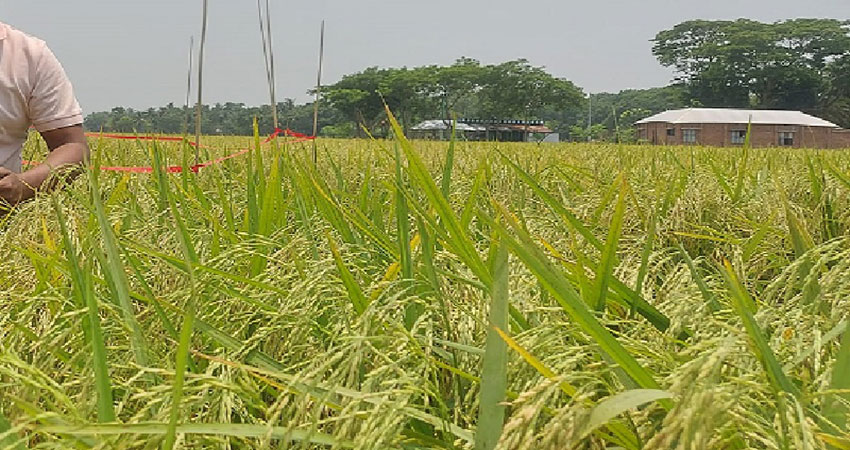Inside the fields of Bangladesh, a beacon of hope is rising within the shape of BINA Dhan-25, a rice range that holds promise for reworking agriculture in the united states. Developed via the Bangladesh Institute of Nuclear Agriculture (BINA), this rice variety is garnering attention for its capacity to deal with challenges confronted by using farmers and make contributions to meals protection. This text explores the importance of BINA Dhan-25 and its hopeful impact on Bangladesh’s agricultural panorama.
History of BINA Dhan-25
1. Research and improvement
BINA Dhan-25 is a fabricated from full-size studies and improvement achieved by using the Bangladesh Institute of Nuclear Agriculture. Scientists and agricultural professionals have dedicated efforts to create a rice variety that not most effective improves yield but additionally withstands environmental stressors, pests, and diseases.
2. Hybridization and Genetic Enhancement
The rice variety is a result of hybridization and genetic enhancement strategies. By way of combining acceptable developments from distinctive varieties, BINA Dhan-25 goals to offer a resilient and excessive-yielding choice for farmers, contributing to improved productiveness within the agricultural quarter.
Key functions and blessings
1. Excessive Yield capability
One of the standout functions of BINA Dhan-25 is its high yield ability. Farmers cultivating this variety can expect a big growth in rice manufacturing compared to traditional types, addressing the growing demand for meals in the country.
2. Weather Resilience
BINA Dhan-25 exhibits resilience to weather challenges, consisting of changes in temperature and water availability. This feature is crucial for ensuring stable yields in the face of unpredictable weather patterns, contributing to the variation of agriculture to climate trade.
3. Pest and disorder Resistance
Farmers frequently face challenges from pests and illnesses that could devastate crops. BINA Dhan-25 is designed with resistance mechanisms, reducing the reliance on pesticides and ensuring a more sustainable and environmentally pleasant approach to rice cultivation.
Implications for food security
1. Accelerated Rice manufacturing
With its high yield potential, BINA Dhan-25 has the capacity to make a contribution extensively to improved rice manufacturing. As rice is a staple food in Bangladesh, this enhance in manufacturing performs a essential role in improving meals protection for the nation’s population.
2. Diversification of Agriculture
The adoption of BINA Dhan-25 encourages the diversification of agriculture through promoting the cultivation of a resilient and excessive-yielding rice range. This diversification can result in a more robust and sustainable agricultural gadget.
Farmer Adoption and success tales
1. Nice Reception amongst Farmers
Early reports advise a nice reception of BINA Dhan-25 among farmers. The variety’s performance in field trials and initial cultivation has sparked interest, with farmers expressing optimism about its ability to enhance their livelihoods.
2. Fulfillment memories of expanded earning
Farmers who have followed BINA Dhan-25 in pilot applications have suggested achievement tales of elevated incomes. The aggregate of higher yields and decreased input charges has translated into economic advantages for those embracing this progressive rice range.
Government guide and destiny potentialities
1. Authorities Endorsement
Spotting the capability of BINA Dhan-25, the authorities of Bangladesh has shown aid for its sizeable adoption. This endorsement consists of initiatives to offer farmers with access to seeds, schooling, and resources vital for cultivating this promising rice range.
2. Destiny prospects for Sustainable Agriculture
As BINA Dhan-25 profits traction, the future prospects for sustainable agriculture in Bangladesh appearance promising. The range represents a step towards modernizing and optimizing rice cultivation practices, aligning with broader efforts to obtain meals security and environmental sustainability.
Talukdar Tetulia post: BINA Dhan-25 shows hope in Bangladesh
Editorial Note: A Quantum Leap in Agriculture in Bangladesh: In the heart of
Bangladesh’s agricultural landscape, the emergence of BINA Dhan-25, a newly
developed paddy variety, has sparked optimism and opportunity. Farmers like Mannan
Joaddar and Yasir Uddin are experiencing higher yields and better market prices,
thanks to the unique characteristics of this rice, reminiscent of Basmati. The shorter
growth cycle and robust nutritional profile, with 9.1 percent protein content, make BINA
Dhan-25 a game-changer for food security and economic growth. The pioneering efforts
of the Bangladesh Institute of Nuclear Agriculture (BINA) and scientists like Sakina
Khanam are laudable. This innovation holds the promise of reducing import
dependence, strengthening nutritional value, and ushering in a new era of prosperity for
Bangladesh’s agriculture sector. – Talukdar Tetulia, Washington DC | September 29,
2023.




Original post by Sajjad Hossain | Thu May 11, 2023, The Daily Star, BINA Dhan-25 shows hope in Bangladesh
Mannan Joaddar cultivated BINA Dhan-25, a newly developed variety of paddy, on
one bigha of land in Moghi village of Magura 93 days ago.
The 55-year-old farmer is now over the moon. He had not seen such thin and long
grain in his 20 years of farming.
“I am hoping to get around 30 maunds of crop, which would be more than any other
variety I have grown so far. It looks more like Basmati rice,” Mannan told The Daily
Star yesterday.
In the last season, he grew BRRI Dhan-63 on the same land and had about 22 maunds
of paddy. He spent Tk 10,000 to produce the paddy.
This time he is expecting to get more paddy spending the same amount of money.
“BRRI Dhan-63 has a life cycle of over 120 days whereas BINA Dhan-25 can be
harvested in less than 100 days,” the farmer said.
Bangladesh Institute of Nuclear Agriculture (BINA) developed the new variety and
supplied it to the farmers of 396 upazilas of 22 districts last year. This variety was
developed from BRRI Dhan-29, officials said.
BINA officials recently visited two villages in Magura to see the yield.
Around 20 farmers in Moghi of Magura Sadar upazila and Bhaturia Danga of
Mohammadpur upazila cultivated this variety.
Yasir Uddin, a farmer of Bhaturia Danga village, has also grown the variety on his 1.5
acres.
He is expecting to sell the paddy for Tk 1,400 to Tk 1,500 a maund. Last year, he sold
BRRI Dhan-63 for Tk 1,200 to Tk 1,250 per maund.
“I’ve cooked the rice and it tasted good,” he said.
The new variety of paddy comes at a time when many millers cut and shape coarse
rice into fine one using different methods. Nutrients such as zinc and iron are reduced
in the process.
But BINA Dhan-25 needs not excessive processing as the rice is normally fine, said
BINA officials.
Mirza Mofazzal Islam, director general of BINA, said any paddy usually contains 6.5
to 7.5 percent protein, but this has 9.1 percent protein.
“Due to its higher yield, dependence on imports could be reduced.”
The cost for producing this variety on one bigha, including fertilizer, water, pesticide,
and seed, is Tk 10,000, he said.
Sakina Khanam, BINA’a principal scientific officer, who played a significant role in
developing the BINA Dhan-25, said farmers could preserve its seed for a long time.




